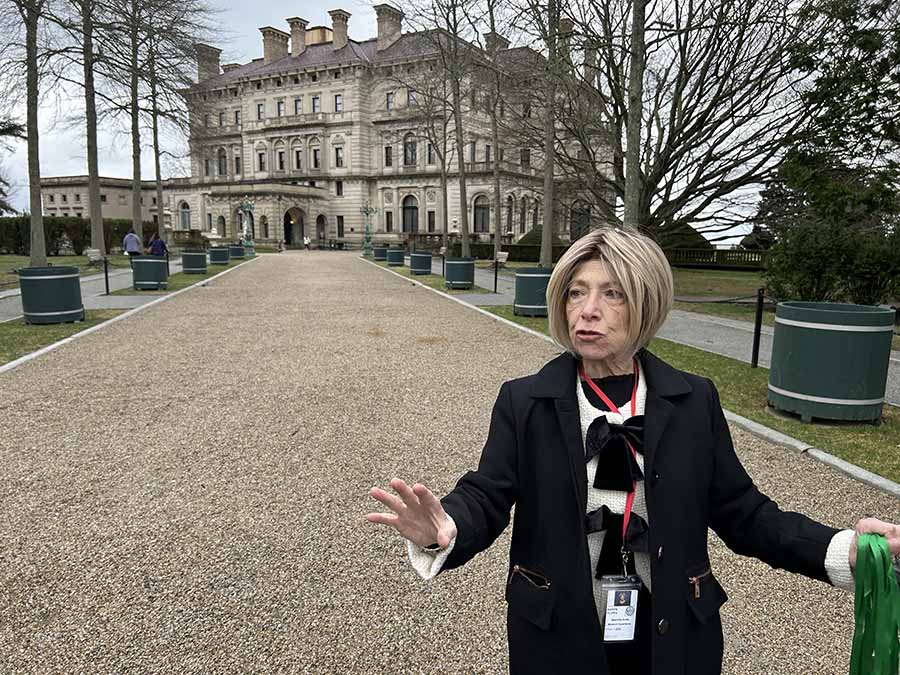
Gilded not gold. Mark Twain, Samuel Clemens (1835-1910), the great American humorist, first called it the Gilded Age.
Karen Flippo, our tour guide at the Breakers, the signature mansion (and the one where Twain attended the party), posed the question. Gilded is not gold, she said, it is a veneer, painted on the mundane, skin deep.
Clemens was not alone. “Where idleness ranks among the virtues,” Dublin’s incomparable Oscar Wilde wrote of his visit to Newport in 1882. In 1730 George Berkeley from Kilkenny wrote to his friend Thomas Prior from Laois that Newport ‘exhibited some of the softest rural and grandest ocean scenery in the world‘.
Newport Rhode Island is a look into the soul of those who splashed their cash and flaunted that veneer. It may have been skin deep, but it great fun to see and reimagine.
Clemens had been invited to one of the lavish parties thrown by the merchant princes from Boston who established a playground of mansions along the seafront of America’s smallest state, Rhode Island (think of it as the size of county Clare, with remarkably similar coastline to match, specifically the shoreline around Kilkee).
“After the civil war we had in industry, millionaires were being made for the first time, a millionaires became billionaires and that’s what we have living in Newport today,” Mark Brodeur, State Tourism Director for Rhode Island says.
Mr Brodeur reminds us that the playground of the wealthy was founded on a more fundamental freedom.. “For example, in the Newport Common Burying Ground we have the Catholic section, the Jewish sector, the most denominations in a burial ground in America, because we had, for the first time, that freedom of religion. Everyone who lives has to die, right?”

90 minutes from Boston
The venue for the Discover New England Tourism forum 2025, Newport is about ninety minutes out of Boston, the last remaining large wooden-house city in the United States.
Newport’s buzzing with fresh energy in 2025. Construction is underway on the NOAA Marine Operations Center-Atlantic at Naval Station Newport, a $146.8 million project funded partly by the Inflation Reduction Act. Breaking ground in 2024, it’s set to finish by 2027, bringing a new pier for four large vessels, a floating dock, and a support building. It’s a big win for climate research and local jobs, with a focus on sustainability—think LEED certification and lower-emission ships.
Food scene’s heating up too. Helly Hansen opened a 6,400-square-foot store on Memorial Boulevard, catering to Newport’s sailing crowd with technical gear—a nod to the city’s global sailing rep. New dining spots are trickling in, though specifics are still emerging—keep an eye out for pop-ups and seasonal openings as summer nears.
Infrastructure-wise, the South Pier Redevelopment Project in Jamestown (just across the bridge) is progressing, with phase one wrapping up by late 2025. It’s adding mixed-use space and better harbor access, indirectly boosting Newport’s connectivity. And at the Newport Gateway Center, a new application portal for Zoning Board reviews launched this week (April 9), streamlining local planning.
The Newport Folk Festival (July 25-27) is already generating buzz with early ticket sales, promising another legendary lineup at Fort Adams. The Newport Flower Show (June 20-22) at Rosecliff will bring fresh floral displays, and the Newport International Polo Series (June 7-September 27) is back with tailgate-ready matches.
On the horizon, 5,000 new hotel rooms are planned across Newport County over the next few years, signaling a tourism boom. For now, spring 2025 is all about outdoor vibes—daffodils, races, and oysters—mixed with long-term growth in science and sailing.

Things to do, Iconic Outdoor Adventures
- Cliff Walk: This 3.5-mile trail along the coast offers stunning ocean views on one side and Gilded Age mansions on the other. Spring’s mild weather makes it ideal, though detours are in place between Narragansett Avenue and Webster Street due to structural damage—check updates before heading out.
- Ocean Drive: A 10-mile scenic loop around Newport’s coastline, perfect for a drive or bike ride. Stop at Brenton Point State Park for a picnic or kite-flying with Atlantic vistas.
- Fort Adams State Park: Explore this historic fort with guided tours (starting at $20 for adults), or just soak in the panoramic views of Newport Harbor and Narragansett Bay. It’s a great spot for fishing or a waterfront walk.

Things to do, Gilded Age Mansions
- The Breakers: The grandest of Newport’s “summer cottages,” this Vanderbilt estate is a must-see for its opulent interiors and audio tours (adults $29). Open daily, with spring gardens starting to bloom.
- Marble House: A Beaux-Arts marvel built for Alva Vanderbilt, it’s $25 to enter. The Chinese Tea House on the grounds offers a $35 afternoon tea on weekends—book ahead.
- The Elms: Known for its classical architecture and servant-life tours, it’s another $25 gem. Pair it with a stroll through its sunken gardens.
Things to do, Seasonal Spring Vibes
- Daffodil Days: Running now through April, nearly 1.5 million daffodils are blooming citywide—roadsides, parks, and along the Cliff Walk. Catch the Newport Rhode Races on April 19 for a marathon, half-marathon, or 5K through this yellow sea.
- Sachuest Point National Wildlife Refuge: A 2.4-mile loop trail with ocean views, wildlife spotting (think migratory birds), and no crowds. Perfect for a quiet spring hike.
Things to do, Cultural & Quirky Stops
- International Tennis Hall of Fame: Housed in a historic casino, it’s $20 to explore tennis history on grass courts where legends played. Open daily, with a fresh spring vibe on the grounds.
- Newport Art Museum: Lesser-known but packed with local art—current exhibits like “Shaman Ladders and Other Stories” (through November) blend nature and creativity. Entry’s $15.
- Mapparium: A short trip to the Mary Baker Eddy Library in Back Bay (technically Boston, but a doable day trip) gets you inside a three-story stained-glass globe with wild acoustics. It’s a hidden gem for $6.
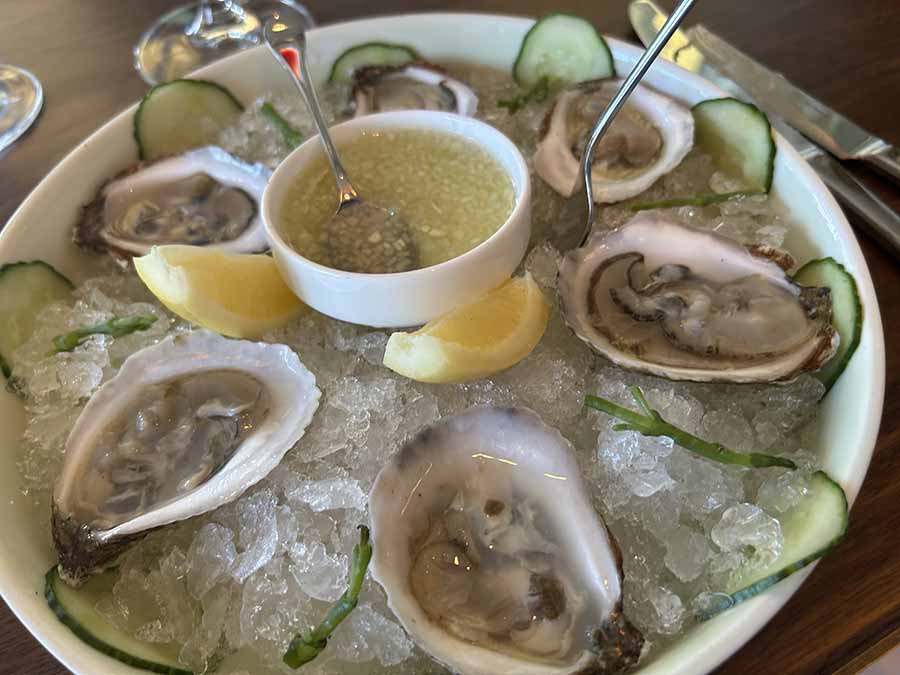
Things to do, Food & Drink
- Bowen’s Wharf: Grab oysters at Clarke Cooke House’s raw bar—freshly shucked from local farms—or sip a cocktail with harbor views. The Newport Oyster & Chowder Festival is coming in May, but the wharf’s vibe is year-round.
- Newport Vineyards: A 100-acre farm with wine and beer tastings, plus spring events like Sip & Savor Sundays. It’s a 15-minute drive from downtown.
- Thames Street: Hit Flo’s Clam Shack for clam cakes or Thames Street Kitchen for farm-to-table dishes like raviolo with serrano ham—reserve early for the bar seats.

Things to do, Unique Experiences
- Sailing: Newport’s the “Sailing Capital of the World”—book a tour on a classic 12-meter yacht (around $50-$100) to raise sails and cruise Narragansett Bay.
- Spectacle Island: A 40-minute ferry from Long Wharf lands you on this harbor island with trails, a beach, and skyline views. Spring’s quiet, so it’s all yours.
- Helicopter Tours: Newport Helicopter Tours offers a bird’s-eye view of mansions and coastlines—pricey (starting at $150), but unforgettable.
Off-the-beaten-path.
These spots dodge the usual tourist hype, offering a quieter, quirkier side of the city with a mix of history, nature, and local flavor:
- Battery Park: Off Washington Street in Jamestown (a short hop via ferry or bridge), this overgrown relic has crumbling WWII gun emplacements and a killer view of Newport’s skyline across the water. Kids climb the concrete slabs while adults fish off the rocks. No fee, just a gritty vibe.
- Beavertail Lighthouse and Park: Also in Jamestown, a 10-mile drive from Newport, this 1856 beacon sits on a wild, windy point with tide pools and granite cliffs. The museum’s free (donations welcome), and the views stretch to Block Island on a clear day. Spring’s quiet—fewer tourists than summer.
- Boyd’s Windmill: In Middletown’s Paradise Park, this 1810 eight-sider is Rhode Island’s only working smock windmill. It’s a quirky slice of history, open Sundays in summer (likely starting June 2025), but you can peek anytime. Free, with a grassy hill for lounging nearby.
- Castle Hill Cove: Near the Castle Hill Lighthouse off Ocean Drive, this sheltered inlet’s a paddleboarder’s dream—or just a spot to skip stones. No crowds, no fees, just a rugged beach and a peek at the lighthouse’s backside. Park at the lot and hike down.
- Common Burying Ground: On Farewell Street, this colonial cemetery’s packed with 17th-century headstones—winged skulls and faded epitaphs. It’s less touristy than the synagogue’s plot, with a moody, tangled charm. Free to explore, especially at dusk.
- Evelyn’s Drive-In: In Tiverton, a 20-minute ride from Newport, this no-frills seafood shack on Nanaquaket Pond serves killer lobster rolls and clam cakes. It’s cash-only, picnic-table vibes, and locals swear by it over flashier spots. Open spring through autumn—check hours.
- Fort Wetherill State Park: Across the bay in Jamestown (a quick ferry or drive via the Newport Bridge), this 61-acre park has abandoned WWII bunkers you can scramble over, plus cliffs overlooking the East Passage. Trails lead to secluded coves—perfect for kayaking or a raw coastal hike. Free entry, bring sturdy shoes.
- Gooseneck Cove: Tucked off Hazard Road near Sachuest Point, this salt marsh is a locals-only spot for kayaking or birdwatching. Spring brings egrets and ospreys, and the tidal flats glow at sunset. No signs point you here—park near Third Beach and wander west. Free, quiet, and raw.
- Green Animals Topiary Garden: Tucked in Portsmouth, just north of Newport, this estate hosts over 80 animal-shaped shrubs—think elephants, bears, and giraffes carved from yew and boxwood. It’s a whimsical detour from the Gilded Age mansions, with a Victorian vibe and a toy collection in the Brayton House. Open daily in spring, $21 for adults, and a 15-minute drive from downtown.
- Hammersmith Farm Ruins: On Ocean Drive near Fort Adams, this was Jackie Kennedy’s childhood summer spot and her 1953 wedding site. The mansion’s gone—burned in 1974—but overgrown gardens, stone walls, and a lonely gatehouse remain. It’s private land, so you can’t trespass, but peeking from the road feels like uncovering a ghost story.
- Island Cemetery: Off Warner Street, this sprawling 19th-century graveyard’s got ornate Victorian stones and the graves of Gilded Age tycoons like Cornelius Vanderbilt. It’s less polished than the mansions, more haunting, and free to roam—perfect for a reflective walk.
- Newport Tower: In Touro Park, this mysterious stone structure’s origins are a head-scratcher—Viking relic, colonial windmill, or something else? It’s weathered and odd, with no admission fee. Locals debate it over beers; you can just gawk and ponder.
- Norman Bird Sanctuary: Also in Middletown, this 325-acre preserve has 7 miles of trails through woods, ridges, and ponds. Spring’s alive with warblers and wildflowers, and the Hanging Rock overlook gives you a panorama without the Cliff Walk crowds. $10 entry, worth it for the solitude.
- Paradise Rock: Off Ocean Drive near Brenton Point, this unmarked spot’s a local secret. It’s a rugged outcrop with crashing waves and a gritty view of Castle Hill Lighthouse. No signs, no fuss—bring a camera or just sit and breathe. Free, but you’ll need a car or bike to find it.
- Purgatory Chasm: In Middletown, near Second Beach, this narrow geological slit in the cliffs drops 50 feet—local lore says it’s cursed, or at least a daredevil’s playground. A short trail off Tuckerman Avenue gets you there. It’s free, eerie, and overlooked by mansion-hoppers.
- Ragged Island Brewing: Off Bristol Ferry Road in Portsmouth (15 minutes from Newport), this microbrewery’s a low-key gem with picnic tables and IPAs like “Anchor Drop.” No frills, just good beer and water views. Locals keep it hush—check their taproom hours.
- Sachuest Point National Wildlife Refuge: A 242-acre haven in Middletown, minutes from Newport, with 2.5 miles of trails winding through salt marshes and rocky shores. Spring brings migratory birds—over 200 species—like red-tailed hawks and harriers. No entry fee, just peaceful ocean views and zero crowds.
- Sakannet Greenway Trails: Starting near Sandy Point Beach in Portsmouth, these winding paths cut through meadows and woods, linking to the bay. Spring’s daffodil season spills over from Newport, and it’s a quiet escape. Free, with parking at the trailhead.
- Touro Synagogue Cemetery: Hidden off Bellevue Avenue, this tiny graveyard dates to 1677, tied to the oldest synagogue in the U.S. It’s eerie and serene, with weathered slate stones and a link to Newport’s Jewish roots. Longfellow wrote about it, and it’s free to wander—enter through Touro Park if the gate’s open.
- Weaver Cove: Off Burma Road near the Naval Station, this forgotten waterfront’s got derelict piers and a scrappy charm. It’s technically public, but feels like a trespass—perfect for a gritty sunset. Free, but watch your step.

Newport Mansions
Newport Mansions manage a collection of historic “summer cottages” built primarily during the Gilded Age (late 19th to early 20th century) by America’s wealthiest families, such as the Vanderbilts and Astors. These opulent estates, located along Bellevue Avenue and the Cliff Walk, represent architectural and social history spanning the Colonial era to the Gilded Age. They are managed by two key organizations:
The Preservation Society of Newport County was established to protect, preserve, and present Newport’s architectural heritage, focusing on 11 historic properties, seven of which are National Historic Landmarks.
Its portfolio of mansions are open to the public with audio tours, guided tours, and special exhibitions. The Preservation Society’s app enhances visitor experiences with The Gilded Age content, while the NRF’s Rough Point tours delve into Doris Duke’s philanthropy and Newport’s craft traditions. Educational programs cover landscape history, Gilded Age social dynamics, and preservation techniques.
The mansions attract millions of tourists, boosting Newport’s economy. Events like the Newport Flower Show and holiday displays draw diverse crowds. The Society oversees:
- The Breakers (1895): A 70-room Italian Renaissance-style palazzo designed by Richard Morris Hunt for Cornelius Vanderbilt II, featuring 500,000 cubic feet of marble and advanced Gilded Age technology.
- Marble House (1892): Built for William K. Vanderbilt, designed by Hunt, with lavish marble interiors and a Chinese Tea House.
- The Elms (1901): A French chateau-style mansion for Edward Berwind, designed by Horace Trumbauer, with formal gardens and Venetian paintings.
- Rosecliff (1902): Modeled after Versailles’ Grand Trianon, designed by Stanford White for Theresa Oelrichs, known for its Baroque Revival ballroom.
- Chateau-sur-Mer (1852): A High Victorian mansion for William Wetmore, showcasing early Newport wealth.
- Hunter House (c.1748): A Georgian Colonial masterpiece, reflecting Newport’s mercantile past.
- Isaac Bell House (1883): A Shingle-style architectural gem by McKim, Mead & White.
- Chepstow (1861): An Italianate villa with period furnishings.
- Kingscote (1841): A Gothic Revival cottage, one of the earliest “summer cottages.”
- The Breakers Stable and Carriage House (1895): Houses Vanderbilt memorabilia.
- Green Animals Topiary Garden (c.1860): A unique estate with sculpted topiary and gardens.
The Society offers audio and guided tours (including servant life and behind-the-scenes tours), hosts events like the Newport Flower Show, Wine & Food Festival, and Christmas at the Mansions, and maintains landscapes and interiors. It also supports educational programs and preservation efforts, such as combating beech leaf disease and restoring specimen trees. Ticket revenue funds ongoing conservation. The Society has also contributed to HBO’s The Gilded Age, with mansions like The Breakers and The Elms used as filming locations, enhancing historical authenticity.
Newport Restoration Foundation
Newport Restoration Foundation (NRF), founded by Doris Duke in 1968, set about preserving Newport’s wood framed colonial architecture and manages Rough Point as a museum. It stewards one of the largest collections of 18th-century houses in the U.S. An English Manorial-style mansion built in 1887 for Frederick Vanderbilt, later owned by Doris Duke. It features Duke’s art collection, Olmsted-designed grounds, and panoramic ocean views. The NRF owns 73 restored 18th-century houses in Newport’s The Point and The Hill neighborhoods, including the William Vernon House (c.1708) and the Dayton-James House (1758). These are leased to tenant-stewards who maintain them in exchange for market-rate rent.

The Breakers
Best known of the Gilded Age mansions, the Breakers in Newport, Rhode Island, offers visitors a deep dive into the opulence of what is known locally America’s Gilded Age, when the harbour town became a playground for the merchant princes form Boston, 90 miles upcoast.
The Breakers was built between 1893 and 1895 as a summer “cottage” for the Vanderbilt family, this 70-room Italian Renaissance-style palazzo, designed by architect Richard Morris Hunt, stands as Newport’s grandest mansion and a National Historic Landmark. Located at 44 Ochre Point Avenue along the Cliff Walk, it’s managed by the Preservation Society of Newport County. Here’s what visitors can expect:
The house, the Vanderbilt family’s summer “cottage”—a 70-room Italian Renaissance-style mansion that stands as Newport’s crown jewel, sits on a 13-acre estate overlooking the Atlantic Ocean, framed by manicured lawns and a dramatic wrought-iron gate salvaged from Paris. The approach via the tree-lined driveway sets a regal tone, with the mansion’s imposing limestone façade, inspired by 16th-century Genoese palaces, and its ornate wrought-iron gates (salvaged from Paris).
The salty ocean breeze and distant waves add a sensory layer to the experience. The sprawling lawns and sculpted hedges hint at the extravagance within. The annals of opulence unfold over 138,000 square feet unfold across five floors, though tours focus on the main living areas (about 33 rooms are accessible):
Constructed between 1893 and 1895 by architect Richard Morris Hunt for Cornelius Vanderbilt II, this National Historic Landmark at 44 Ochre Point Avenue along the Cliff Walk is managed by the Preservation Society of Newport County.
Beyond the rooms, marvel at the mansion’s engineering—steel trusses eliminated fire risk (a lesson from a prior Vanderbilt home burning down), and 14 bathrooms hosted both fresh and saltwater plumbing, a rarity in 1895. The basement’s coal-fed boiler system, visible on specialty tours, powered this behemoth.
After the interior, explore the terraces and gardens (weather permitting). The south lawn sweeps down to the Cliff Walk, offering panoramic ocean vistas. The children’s playhouse, a mini-mansion itself, hints at the family’s casual side.
Summer and autumn weekends draw big crowds—expect lines and a busy vibe, though the audio tour keeps things flowing. Off-season (winter/early spring) is quieter, with shorter waits. The mansion’s scale absorbs people well, but narrow staircases can bottleneck.
A self-guided audio tour is the standard experience, included with admission ($29 adults, $10 youth 6-12, free under 6), runs daily from 10 AM (9 AM in summer) to 5 PM, with last entry at 4 PM. Available via a free app or handheld device, the audio guide offers detailed narration in multiple languages, including a family version with Vanderbilt descendant voices. It takes 45-60 minutes but allows flexibility to linger.
Guided specialty tours are offered seasonally. Options include “Beneath The Breakers” (exploring servant spaces and mechanical systems). These require advance booking and aren’t always available—check the Preservation Society’s schedule. They cost extra ($10-$20) and require advance booking.
Expect to be awed by excess—33,000 square feet of living space, 27 fireplaces, and decor costing millions even in 1890s dollars (total construction: $7 million, about $200 million today). The audio tour weaves tales of Vanderbilt life, from lavish balls to the 60+ servants who kept it running, balancing history with human stories. It’s less interactive than modern museums but rich in atmosphere—every corner drips with wealth, from hand-painted ceilings to imported marble. Pair it with the Ocean Drive or Cliff Walk for a full Newport day, and you’ll leave marveling at a bygone era’s audacity. Highlights include:
- Great Hall: A jaw-dropping entry, 50 feet high and wide, with a soaring coffered ceiling, red marble columns, and gilded cornices. The grand staircase, inspired by the Paris Opera House, and a massive crystal chandelier set the tone of excess.
- Dining Room: A palatial space with 20-foot ceilings, twin Baccarat chandeliers, and rose alabaster walls. The 12-foot dining table, extendable to seat 34, reflects the scale of Vanderbilt entertaining.
- Music Room: A Louis XIV-style salon dripping in gold leaf and silk, designed by French firm Allard et Fils, where recitals once entertained elite guests.
- Morning Room: A delicate, pastel-hued retreat with platinum-leaf wall panels and a ceiling painted by Italian artists, offering ocean views through French doors.
- Library: A walnut-paneled haven with a towering fireplace, leather-bound books, and intricate carvings—cozy yet ostentatious.
- Billiard Room: Dark and masculine, with marble mosaics, an alabaster light fixture, and a vaulted ceiling mimicking a Turkish bath.
- Mrs. Vanderbilt’s Bedroom: A feminine counterpoint with silk upholstery, a carved canopy bed, and ocean-facing balcony access.
Tickets can be bought online or on-site; multi-mansion passes ($46-$79) include The Breakers plus other Preservation Society properties like Marble House or Rosecliff. The standard tour takes 1-1.5 hours with lingering; specialty tours may add 30-60 minutes. The first floor is wheelchair-friendly via a ramp, but upper floors require stairs (no elevator). Audio tours include transcripts for hearing-impaired visitors. Photography is allowed for personal use, no flash or tripods. A welcome centre offers a short film on the Vanderbilts, and a gift shop sells Gilded Age-inspired trinkets. No food is sold inside, but picnic spots abound nearby.

Rosecliff – The Great Gatsby Mansion
Venue for an event to commemorate the centenary of the publication of the Great Gatsby on April 10, 1925, Rosecliff Mansion in Newport was where the 1974 movie starring Robert Redford was filmed, offering a captivating glimpse into the elegance and extravagance of the Gilded Age.
Located at 548 Bellevue Avenue, this iconic estate, commissioned by silver heiress Theresa Fair Oelrichs in 1899 and completed in 1902, was designed by architect Stanford White to emulate the Grand Trianon at Versailles. Managed by the Preservation Society of Newport County, Rosecliff is renowned for its romantic architecture and storied past as a social hub.
Approaching Rosecliff along Bellevue Avenue, you’re greeted by its pristine white terra-cotta façade, adorned with graceful columns and French-inspired details. The mansion sits on a 6.5-acre estate, its front lawn framed by a heart-shaped rose garden and its rear opening to sweeping views of the Atlantic Ocean near the Cliff Walk. The salty breeze and distant waves enhance the fairy-tale ambiance.
The primary experience is the self-guided audio tour included with admission ($25 adults, $10 youth 6-12, free under 6), is available daily from 10 AM to 5 PM (9 AM in summer), with last entry at 4 PM. The audio guide—accessible via a free app or handheld device—offers narration in multiple languages, including a family-friendly version. It takes 45-60 minutes, allowing you to explore at your own pace.
Rosecliff’s 40 rooms (about 15-20 are open to the public) showcase a lighter, more airy opulence compared to darker Newport estates like The Breakers. Key spaces include:
- The crown jewel is the ballroom: —a 40-by-80-foot marvel, the largest private ballroom in Newport. With 18-foot ceilings, crystal chandeliers, gilded wall panels, and French doors opening to a terrace, it’s where lavish parties hosted 300+ guests. Its fame grew as a filming location for The Great Gatsby (1974) and 27 Dresses.
- Grand Staircase: A heart-shaped limestone staircase in the foyer, adorned with a wrought-iron balustrade, sets a romantic tone as you ascend to the second floor.
- Salon: A pastel-hued retreat with Louis XVI-style furnishings, silk drapes, and ocean views—perfect for imagining tea parties or intimate gatherings.
- Dining Room: Elegant yet restrained, with a massive fireplace, intricate plasterwork, and seating for grand dinners under a coffered ceiling.
- Library: A cozy, wood-paneled nook with built-in shelves and a fireplace, offering a quieter contrast to the ballroom’s grandeur.
- Second-Floor Bedrooms: Modest by Gilded Age standards, these showcase Theresa Oelrichs’ taste with delicate decor and personal touches like floral wallpapers.
- Architectural Charm: At 33,000 square feet, Rosecliff feels grand yet livable, with its H-shaped layout maximizing light and airiness. The terra-cotta exterior, shipped from New Jersey, glows in sunlight, while interior details—hand-painted ceilings, imported marbles—reflect White’s Beaux-Arts mastery. The mansion cost $2.5 million in 1902 (about $80 million today), a bargain compared to its peers.
- Grounds and Views: After the interior, explore the manicured gardens and oceanfront terrace (weather permitting). The rose garden, though smaller today, nods to the estate’s name, while the back lawn offers Cliff Walk vistas—perfect for photos or a quiet moment. The fountain courtyard, with its bubbling centerpiece, adds a Versailles-like touch.
Expect to be enchanted by Rosecliff’s blend of grandeur and intimacy—less overwhelming than The Breakers but equally evocative of Newport’s golden era. The audio tour paints a vivid picture of Theresa Oelrichs’ legendary parties (like the 1904 “Bal Blanc,” where all wore white) and the mansion’s Hollywood cameos, from True Lies to Amistad. You’ll feel the romance of a bygone age in the ballroom’s mirrored glow or the staircase’s graceful curve, balanced by the fresh ocean air outside. It’s a shorter, sweeter taste of Newport’s Gilded Age—perfect for history lovers, architecture buffs, or anyone seeking a brush with elegance.
Rosecliff’s breathtaking beauty lies in its harmony of design and setting—a Newport treasure that feels like stepping into a dream.

Harbour Island Resort, Newport, Rhode Island
The venue for the Discover New England Tourism forum 2025, Harbour Island Resort located in Newport, Rhode Island, about 70 miles south of Boston, formerly known as Gurney’s Newport Resort & Marina, underwent a $50 million renovation and reopened in April 2024. Here’s what visitors can expect based on its current offerings:
Situated on Goat Island in Narragansett Bay, the resort offers a secluded island escape just a mile from downtown Newport. Connected by a causeway, it’s surrounded by water, providing 360-degree views of Newport Harbour and the bay. The 10-acre property blends coastal charm with modern luxury, featuring expansive grounds and a historic lighthouse (Newport Harbour Light, built in 1842) at its northern tip.
The resort balances a refreshed, contemporary feel with New England traditions. After its renovation, expect updated interiors with a nautical aesthetic—think soothing tones like lavender and celery green in the spa, paired with timeless seaside vibes. It’s family-friendly yet sophisticated, appealing to couples, groups, and solo travelers alike.
With 257 rooms and 18 suites, options range from cozy standard rooms to spacious suites with private balconies overlooking the water. Rooms feature modern amenities like refrigerators, free Wi-Fi, and cable TV, with some offering Harbour or bay views. The renovation promises a cleaner, more polished experience, though past reviews note occasional maintenance hiccups.
Expect a mix of relaxation and adventure. You might spend mornings kayaking or biking, afternoons by the pool or spa, and evenings dining with sunset views. The staff are generally praised for friendliness, though some past guests noted slow service or minor upkeep issues pre-renovation—hopefully addressed in the 2024 refresh. The resort’s seclusion feels special, yet its proximity to Newport’s historic charm keeps exploration easy. Whether you’re savoring a lobster roll at 1639 or sipping a cocktail by the fire pits, the waterfront setting is the star. Activities and Amenities:
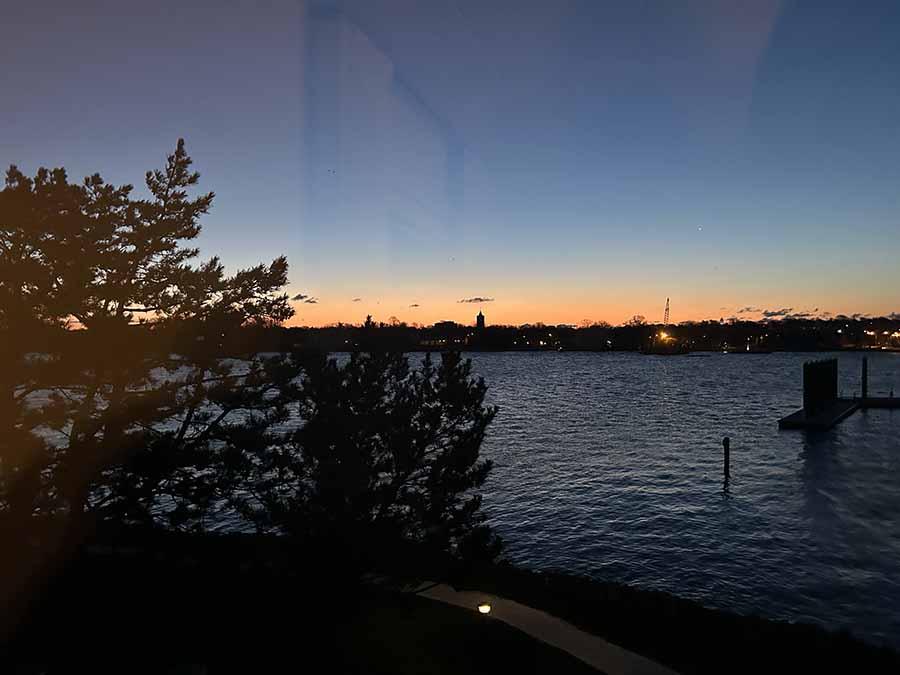
- Pools: Newport’s only seasonal outdoor saltwater pool plus a year-round heated indoor pool—perfect for swimming regardless of weather.
- Spa: The Seawater Spa offers massages, facials, and nail services in a serene setting with floor-to-ceiling sea views.
- Marina: A 22-slip marina accommodates boats up to 240 feet, with full resort privileges for docking guests (open May to October).
- Outdoor Fun: Complimentary bikes, inflatable paddleboards, and kayaks are available seasonally on a first-come, first-served basis, with upgrades like electric bikes or tandem kayaks for a fee.
- Kids’ Club: A seasonal program keeps younger guests entertained with curated activities.
- Fitness: A 24-hour gym with cardio machines and weights caters to wellness enthusiasts.
- Dining and Drinks: The resort is a culinary destination with multiple waterfront options:
- 1639 Restaurant: Open daily for breakfast, lunch, and dinner, it serves seasonal, locally sourced dishes (especially seafood) with two outdoor decks overlooking the bay and an indoor dining room facing the Harbour.
- The Pineapple Club: A lively outdoor spot with panoramic views, live music, cabana seating (including an adults-only section), and expanded service to the marina deck. Expect fresh cocktails and light bites.
- The Firepits: Cosy up on couches by outdoor fire pits for sunset cocktails and small plates—ideal for chilly evenings.
- The Bakery: A lobby coffee shop offering artisanal pastries, salads, and sandwiches to grab and go.

Ocean Drive in Newport, Rhode Island
The World-Famous Ocean Drive in Newport, Rhode Island—often called the Ocean Drive Historic District or simply the “Ten-Mile Drive”—is a scenic loop that winds along the southern coast of Aquidneck Island, offering visitors a captivating blend of natural beauty, historic landmarks, and Gilded Age grandeur. Spanning roughly 10 miles, this route is celebrated for its commanding coastal views and tranquil charm, making it a must-do for anyone visiting Newport. Here’s what visitors can expect:
The drive hugs the rugged Atlantic shoreline, delivering heart-stopping vistas of crashing waves, rocky cliffs, and open ocean. Starting just off Bellevue Avenue or from downtown Newport at Thames Street and Wellington Avenue, you’ll pass by Narragansett Bay before reaching the expansive Atlantic. The salty breeze and rippling waves set a soothing backdrop, especially at sunrise or sunset when the sky ignites with color.
As you cruise along, you’ll catch glimpses of opulent homes—less formal than the grand Bellevue Avenue mansions but still impressive. Highlights include Hammersmith Farm, where Jackie Kennedy grew up (visible from the road), and the lavish compounds near private beaches like Bailey’s and Hazard’s. These properties, often perched on dunes or low hills, showcase a mix of Victorian castles and modern luxury builds.
While many beaches along the drive are private (like Hazard’s and Bailey’s), Gooseberry Beach is public (with a parking fee) and located in a calm cove—great for swimming or lounging. Pull-off spots allow you to stretch your legs, snap photos, or watch sailboats glide by.
The open hills and occasional scrubby patches host birds and small wildlife, while the ocean often reveals seals or seabirds, especially near Brenton Point. The landscape, partly shaped by Frederick Law Olmsted, feels both wild and curated.
The well-marked route loops around, taking 30 minutes without stops, but plan for 2-3 hours to explore. It’s free and open to the public, though summer weekends get busy with cars, cyclists, and walkers—drive slowly and stay alert. Biking or walking parts of it (like from Brenton Point) is also popular, though there’s no separate paved trail; you’ll share the road.
Begin at the end of Bellevue Avenue (Ocean Avenue and Coggeshall Avenue) for a mansion-to-ocean flow, or from Thames Street near the Harbour for a waterfront kickoff. Signs guide you either way.
Dawn offers solitude and a painterly sky; sunset is stunning but crowded—arrive early to claim a spot. Spring and autumn bring fewer people and vibrant foliage.
Visitors can expect a leisurely, visually rich journey that blends Newport’s maritime soul with its storied past. Whether you’re a first-timer, a photographer, or a nature buff, Ocean Drive delivers a quintessential New England coastal experience—unscripted, affordable, and unforgettable.
The route is dotted with notable stops:
- Fort Adams State Park: A massive 19th-century coastal fort (open for tours late May to mid-October, $12 adults, $6 youth), it’s the largest of its kind in the U.S. and offers views of Newport Harbour and the Pell Bridge. It’s also home to the Newport Folk and Jazz Festivals.
- Castle Hill Lighthouse: A picturesque, still-active beacon from 1890 near the Castle Hill Inn, perfect for photos though not open to the public.
- Brenton Point State Park: A rugged promontory with free parking, ideal for picnics, kite-flying, or strolling the rocky shore. The park’s stone tower and ocean vistas are standout features.
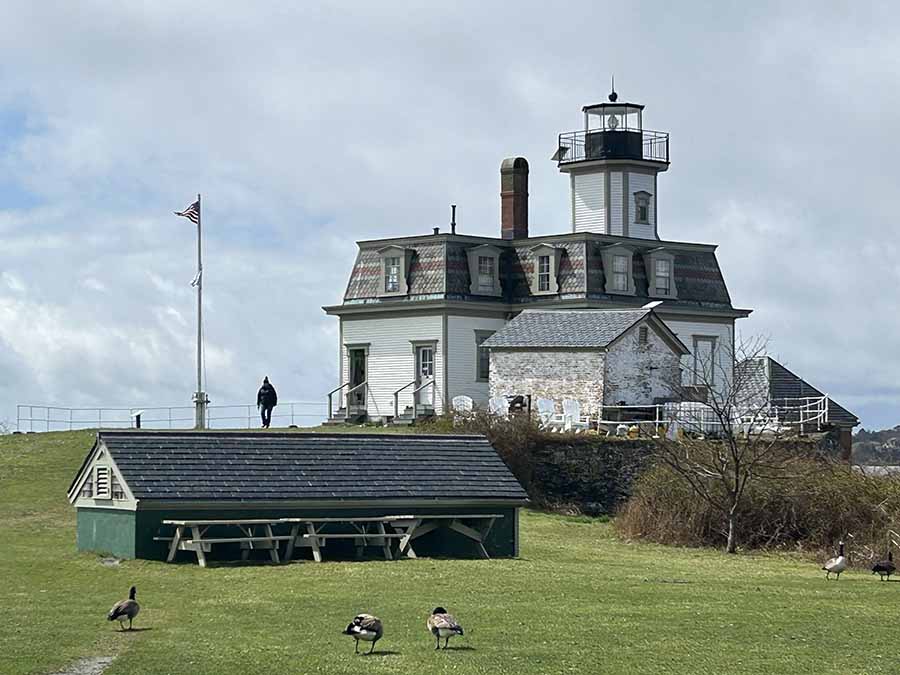
Rose Island
It is a short ferry ride to Rose Island, where guests can overnight in a lighthouse, or day visitors disembark for 1-2 hours (exact time varies by tour). Located on an 18.5-acre island in Narragansett Bay, just a mile offshore from Newport, this restored 1870 lighthouse is a living museum and a private aid to navigation, maintained by the Rose Island Lighthouse and Fort Hamilton Trust.
The dock is small, so you’ll step onto a beach or pathway leading to the lighthouse grounds. From March 1 to August 15, nesting bird season restricts access to the wildlife refuge beyond the lighthouse area, but after August 15, the full island opens up. Wear sturdy shoes—paths can be uneven—and watch for tidal changes if exploring the shore.
The restored keeper’s house, built in a Second Empire style with a mansard roof, doubles as a museum. You’ll step into a Victorian-era interior with period furnishings—think a cozy parlor, kitchen, and bedrooms—showing how keepers lived. A steep, narrow ladder leads to the lantern room (not for the claustrophobic or unfit), offering 360-degree views of the bay, Newport, and distant Jamestown. The climb is optional but rewarding, with the lens itself a fascinating piece of history. Guided tours by island greeters (available May-October) or self-guided brochures reveal the lighthouse’s story, from its 1870 activation to its 1971 decommissioning and 1990s restoration.
The island’s southern end holds remnants of Fort Hamilton, an unfinished Revolutionary War-era fort later used for Navy explosives storage through World War II. You can explore weathered stone barracks and imagine its military past. The island’s beaches invite sea glass hunting, fishing, or tide pool exploration, while birdwatchers might spot egrets, herons, or oystercatchers (respect nesting signs). Picnic tables and Adirondack chairs offer spots to relax with a packed lunch—there’s no food service, so pack in and pack out.
The boat ride takes about 15-30 minutes each way, depending on your starting point and the cruise type. You’ll glide across Narragansett Bay, passing under the iconic Newport Pell Bridge and alongside sights like Fort Adams, Goat Island, and Newport’s bustling Harbour filled with yachts and sailboats. Operators like the Jamestown Newport Ferry, Rhode Island Bay Cruises, or Coastal Queen Cruises often narrate the trip, sharing tales of the bay’s history and pointing out landmarks.
The journey offers panoramic views of Newport’s rocky coastline and the open Atlantic. You’ll see the lighthouse perched on Rose Island’s northern end, its white wooden tower and red roof standing out against the blue water and sky. The 35-foot tower, with its flashing white light every six seconds, is a charming beacon framed by the island’s rugged shores and distant Newport skyline.
Operators like Rhode Island Bay Cruises or Coastal Queen’s “Lighthouse and Mimosa Cruise” may pass Rose Island among other lighthouses (e.g., Castle Hill, Newport Harbour) without stopping, offering narration and a drink but no island time.
Longer Tours (3-7 hours): Save The Bay’s “Ultimate Lighthouse Tour” (7 hours from Providence) or the Jamestown Newport Ferry’s hop-on-hop-off service include a Rose Island stop with lunch provided or time to explore. These often cover multiple lighthouses and islands.
Cruises run seasonally, typically May to October, with some operators like Coastal Queen extending into late autumn. Daily schedules vary—check with providers like Jamestown Newport Ferry ($26 round-trip + $10 island fee) or Rhode Island Bay Cruises ($35-$45 for broader tours). Last boats often leave the island by 4-5 PM.
Visitors can expect a blend of nautical adventure and historical immersion, with the Rose Island Lighthouse as the star—a working relic you can touch, climb, and savor against Newport’s stunning coastal backdrop. The vibe is relaxed yet educational—perfect for history buffs, nature lovers, or anyone seeking a peaceful escape. The boat ride can be breezy (bring a jacket), and the island feels like a step back in time, free of modern bustle. Summer draws more visitors, while spring and autumn offer quieter trips with vibrant scenery.
Whether it’s a quick cruise-by or a hands-on island stop, it’s a uniquely Rhode Island experience.

The Cliff Walk
The Cliff Walk in Newport, Rhode Island, is a world-famous 3.5-mile public trail that winds along the eastern shore of Aquidneck Island, offering visitors a stunning blend of natural beauty and Gilded Age grandeur. Designated a National Recreation Trail in 1975—the first in New England—it stretches from Memorial Boulevard at Easton’s Beach (First Beach) in the north to Bailey’s Beach (Reject’s Beach) in the south. Here’s what visitors can expect on this iconic journey as of April 7, 2025:
The trail traces the rugged Atlantic coastline, delivering breathtaking views of crashing waves, rocky cliffs, and the vast ocean. On one side, you’re treated to the wild beauty of the sea—waves pounding granite outcrops and seabirds soaring overhead—while on the other, you’ll see the manicured lawns and opulent façades of Newport’s legendary mansions, like The Breakers, Rosecliff, and Marble House.
Expect a journey that’s equal parts invigorating and awe-inspiring. The Cliff Walk pairs the raw power of the Atlantic with Newport’s gilded history, offering postcard-worthy views at every turn—whether it’s waves crashing below Rough Point or the Breakers’ turrets against a blue sky. It’s physically moderate overall, though the southern stretch tests your agility and rewards you with solitude amid nature. You might pause to imagine the Vanderbilts’ lavish parties or simply soak in the coastal serenity. Locals call it a “moving meditation”—free, unscripted, and quintessentially Newport.
Whether you tackle the whole trail or a scenic snippet, the Cliff Walk delivers a visceral connection to Rhode Island’s seaside soul—one step at a time. The path varies dramatically along its length:
- Northern Half (1.7 miles): From Easton’s Beach to the 40 Steps (near Narragansett Avenue), it’s a smooth, paved walkway, 3-5 feet wide, with gentle slopes and stone walls or fences. This section is family-friendly and accessible, offering easy strolls past landmarks like Salve Regina University’s Ochre Court and the Breakers’ gates.
- Southern Half (1.8 miles): Beyond the 40 Steps, the trail grows wilder and more challenging. It narrows to a rocky, uneven path, dipping closer to the water’s edge with scrambles over boulders, steep drops (up to 70 feet), and occasional wet spots from sea spray. Highlights include Anglesea (a tunnel under a mansion), Rough Point, and the dramatic Doris Duke Steps near Bailey’s Beach.
- Mansion Views: You’ll pass about a dozen historic estates, some visible through gates or over walls, others partially obscured by hedges. Standouts include:
- The Breakers: Cornelius Vanderbilt II’s Italianate masterpiece looms large near the midpoint.
- Rosecliff: Known for its ballroom and The Great Gatsby film fame, it’s a white stunner near Marine Avenue.
- Marble House: A Beaux-Arts marvel with its Tea House peeking over the cliff.
- 40 Steps: A stone staircase descending to the water, perfect for photos or a breather (though swimming is discouraged due to currents).
- Salve Regina Tunnels: Short, dark tunnels under mansion grounds add a quirky twist—watch your head!
- Chinese Tea House: A whimsical pagoda-style structure at Marble House, ideal for a scenic pause.
- Wildlife and Nature: Expect to spot gulls, cormorants, and occasional seals along the shore. Wildflowers dot the cliffs in spring, while autumn brings golden hues to the bordering estates. The ocean’s roar and salty breeze are constant companions.
- Duration and Pace: Walking the full 3.5 miles one-way takes 2-3 hours at a leisurely pace, longer if you stop frequently. Round-trip (7 miles) requires 4-5 hours, though many opt for shorter segments and retrace their steps or use a shuttle. Access points every half-mile or so (e.g., Narragansett Avenue, Webster Street, Bailey’s Beach) let you customise your trek.
The Chanler at Cliff Walk
The Chanler at Cliff Walk is a historic luxury hotel and one of Newport’s most celebrated addresses. Located at 117 Memorial Boulevard, it is Newport’s only hotel directly on the scenic Cliff Walk, a 3.5-mile coastal path overlooking Easton’s Beach and the Atlantic Ocean. Built in the 1870s as a Gilded Age mansion for Congressman John Winthrop Chanler and Margaret Astor Ward, it blends historic elegance with modern luxury. The Chanler is a Forbes Five-Star and AAA Five-Diamond property, renowned for its panoramic ocean views, manicured gardens, and Michelin 2-key status.
Remy’s Loose dining destination within The Chanler at Cliff Walk offers a playful yet sophisticated twist on French cuisine, elevated by the bold coastal flavors of Rhode Island. Led by Executive Chef Jacob Jasinski, Remy’s Loose promises an inviting, come-as-you-are experience that balances culinary artistry with a relaxed, stylish ambiance, reflecting The Chanler’s heritage as a Gilded Age estate.
The interior blends Parisian flair with coastal cool—think cozy banquettes, open kitchen views, and a design that nods to the property’s storied past. The Terrace at Remy’s Loose is a standout, offering sweeping ocean views across Easton Bay, perfect for unwinding with a drink or meal alfresco. Named after proprietress Lani Shufelt’s niece, the restaurant exudes a familial warmth, making it as welcoming for a casual bite as it is for a special occasion.
Open daily for lunch (12:00 PM to 2:45 PM) and dinner (5:00 PM to 8:45 PM), Remy’s Loose caters to a range of dining styles. The open kitchen lets you peek at the culinary magic, while garden-inspired cocktails spark conversation. It’s less formal than its sister restaurant, Cara, at The Chanler, embracing a lively, approachable vibe. Reservations are highly encouraged (call 401-847-2244 or book online), especially for peak times, as the intimate setting fills quickly.
Expect attentive, professional staff who prioritise flavour and presentation over stiff formality. The Terrace draws sunset seekers, while indoor tables suit those craving a cozier meal.
The restaurant’s design—crafted with input from top architects—features thoughtful touches like nautical accents and a layout that flows seamlessly between indoor and outdoor spaces. It’s effortlessly chic, with a breezy coastal spirit that complements the Cliff Walk location.
The focus is on fresh, local seafood and globally sourced ingredients, with dishes that balance sophistication and approachability. Based on reviews, descriptions from The Chanler, and culinary trends in Newport, here are some signature highlights visitors can expect:
- Madai Snapper a la Plancha: A star dish featuring Japanese red snapper, seared to perfection on a hot griddle, showcasing its delicate texture and rich flavor. It’s often paired with bright, seasonal accompaniments like citrus or herbs, reflecting Rhode Island’s coastal bounty.
- English Pea Ravioli: Handmade pasta stuffed with sweet English peas, served with a light, flavorful sauce—perhaps a butter emulsion or pea shoot garnish. This dish blends French technique with fresh, local produce, earning praise for its elegance and simplicity.
- Spanish Octopus: Tender, caramelised octopus, likely grilled or braised, served with bold accents like smoked paprika or a Rhode Island-inspired twist (think seaweed or local greens). It’s a testament to the kitchen’s skill with seafood.
- Chitarra ‘Fait Maison’: House-made chitarra pasta (a square-cut spaghetti from Abruzzo) tossed with a coastal-inspired sauce—possibly featuring North Atlantic fish or clams. The “fait maison” (homemade) label underscores the artisanal focus.
- Rhode Island Raised Oysters: A raw bar staple, these local oysters are served pristine or with a refined mignonette, highlighting Newport’s shellfish heritage. They’re a must-try for seafood lovers.
- Caramelised Heirloom Carrot: A vegetable-forward standout, these carrots are roasted to intensify their sweetness, paired with a luxurious touch like brown butter or a subtle French glaze—proof that simplicity can dazzle.
- North Atlantic Fish Crudo: A delicate preparation of raw fish (think cod or fluke) with zesty dressings—perhaps yuzu or ginger aioli—marrying French finesse with Rhode Island’s fishing legacy.
Cara Restaurant is The Chanler’s signature Forbes Five-Star restaurant, celebrated as one of the finest dining experiences in Newport. Tucked in a private room with sweeping ocean views, it offers an intimate, exclusive setting with a limited number of guests each evening. Executive Chef Jacob Jasinski crafts contemporary blind tasting menus inspired by European techniques and sustainable New England ingredients, often sourced from The Chanler’s own garden beds. The restaurant has earned accolades, including People Magazine’s “50 Most Beautiful Restaurants in America” and Yankee Magazine’s “Best Hotel Restaurant in Rhode Island.”
The setting is an Intimate dining room with panoramic Atlantic views, elegant decor, and a focus on culinary artistry. The open kitchen features a custom French Bonnet cooking suite, allowing guests to glimpse the creative process.
The vibe is upscale, curated, and interactive, with chefs presenting each course to explain its inspiration and ingredients. The dress code is cocktail or business casual.
- Menus change daily to highlight peak-season ingredients, featuring local seafood, vegetables, and meats. Examples include tuna tartare with micro basil, caviar with asparagus and lemon, and lettuce soup.
- Wine Pairings: An optional pairing from an extensive, Wine Spectator Award of Excellence list is curated nightly to complement each dish.
- Reviews praise the exceptional food and service. A 2024 Yelp review highlighted a six-course “Plunge” tasting menu with wine pairings, describing every dish as “delicious and decadent” and appreciating server Cole’s knowledge of local sourcing. Another review from Always Wander called it one of New England’s finest dining experiences, lauding dishes like caviar and lettuce soup, though noting that scallops and dessert slightly missed perfection. OpenTable reviews commend Chef Jasinski’s team, particularly server Andrew, for outstanding presentation and wine pairings.
- A Yelp review called it a “10/10 experience” for its price, food quality, and Cliff Walk proximity. Another Tripadvisor post from 2022 noted “fabulous lunch on Cliff Walk” with outstanding atmosphere.
- Offerings: 5-course Blind Tasting ($155 per guest, plus tax and gratuity, 5:00 PM seating).8-course Blind Tasting ($225 per guest, 8:00 PM seating).
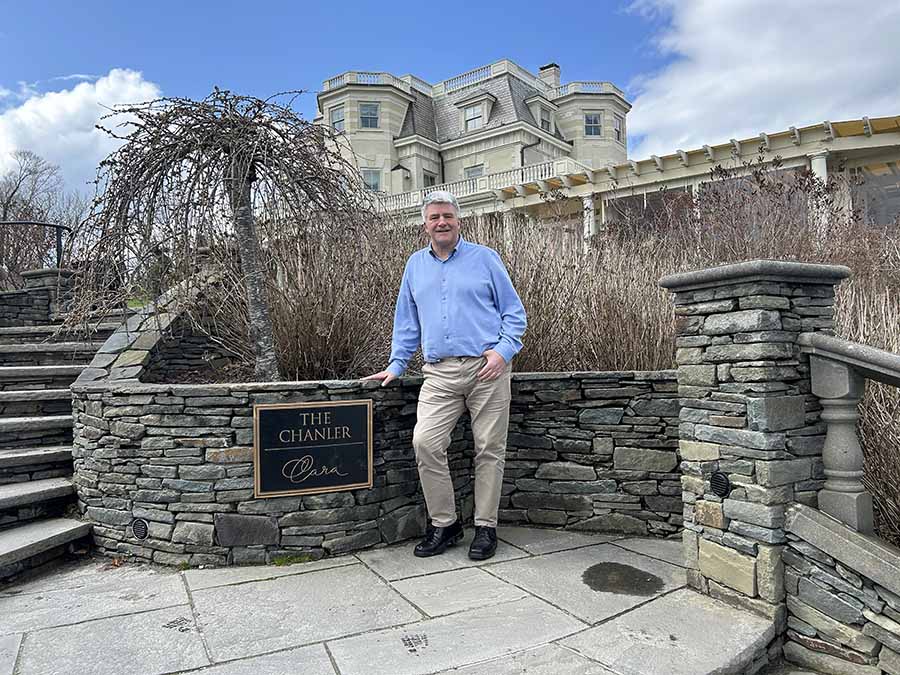
Newport sailing museum
The Sailing Museum, located in Newport, Rhode Island, is a vibrant celebration of sailing’s rich history and culture, housed in the historic Armory Building at 365 Thames Street. Opened on May 10, 2022, it serves as the home of the National Sailing Hall of Fame and the America’s Cup Hall of Fame, making it a must-visit for sailing enthusiasts and curious newcomers alike. Here’s what visitors can expect from this immersive, interactive experience as of April 7, 2025:
Upon arrival, visitors receive a QR-enabled bracelet that personalises their adventure. You’ll start by choosing a boat—experienced sailors pick from seven options, while novices take a short quiz to find their match. This boat becomes your avatar, guiding you through hands-on exhibits and tracking your progress as you earn virtual rewards for your “sailing locker.” The main level, Schoonmaker Hall, is divided into six engaging areas:
- Wind and Water: Explore the science of sailing with dome projections and video displays showing how wind and waves shape the sport.
- The Making of a Sailor: Mental and Physical: Test your mental agility and physical skills—try steering with a tiller or wheel, hoisting a sail, or grinding a winch to feel the effort sailors exert.
- Teamwork: Collaborate at the Teamwork Table to “sail” a boat across a virtual finish line, highlighting the cooperative spirit of the sport.
- Competition: Dive into sailing’s competitive history, including a quiz on famous race finishes and a virtual SailGP experience where you can “fly” across the water.
- Legends of Sailing: Celebrate the National Sailing Hall of Fame and America’s Cup Hall of Fame with touchscreens detailing inductees—designers, Olympians, and champions who’ve shaped sailing since 1851, including the Irish challenge by Thomas Lipton’s series of five J-Class ‘Shamrock’ yachts, built out of mahogany planking over steel frames.
- Hands-On Fun: Design your own burgee (a sailor’s flag) to take home, build a virtual boat, or navigate a course—all embedded with “stealth learning” that weaves in STEAM (Science, Technology, Engineering, Art, and Math) concepts. These activities make the museum as educational as it is entertaining, appealing to kids and adults alike.
- Second Floor: A quieter space with additional exhibits and a private lounge honoring Hall of Famers, offering a reflective look at sailing’s luminaries.
- Historic Setting: The Armory, once the press headquarters for the America’s Cup in 1958 and 1983, ties the museum to Newport’s maritime legacy. Its waterfront location, steps from Newport Harbour, enhances the nautical vibe—arrive by boat to the Ann Street Pier or stroll from downtown.
- Duration and Pace: The average visit lasts 45-90 minutes, though you can linger longer with the interactive elements. It’s self-guided, so you set the rhythm, with staff on hand to explain exhibits or assist.
Open daily from 10 AM to 5 PM (last entry at 4 PM). The museum is a 10-minute walk from Newport’s shops and eateries, with street parking or paid lots nearby.
Tickets: $18 for adults, with discounts for seniors ($15), students/military ($12), and free for kids 10 and under. It’s part of the Museums for All program, offering reduced admission for low-income visitors. A $39 joint ticket includes the Audrain Automobile Museum and International Tennis Hall of Fame.
Expect a blend of history, technology, and fun that demystifies sailing for novices while thrilling seasoned mariners. The museum stresses inclusivity, showing how sailing teaches teamwork, leadership, and resilience—skills that resonate beyond the water. You might leave inspired to try sailing yourself, thanks to resources connecting you to local opportunities, or simply awed by tales of legends like Ted Turner or Dennis Conner. With its high-tech exhibits (e.g., haptic feedback at the tiller) and low-tech charm (e.g., designing a burgee by hand), it’s a dynamic tribute to Newport’s title as the “Sailing Capital of the World.”
Whether you’re a landlubber or a salty sailor, The Sailing Museum delivers a fresh, engaging way to connect with this timeless sport—all against the backdrop of Newport’s seafaring soul.
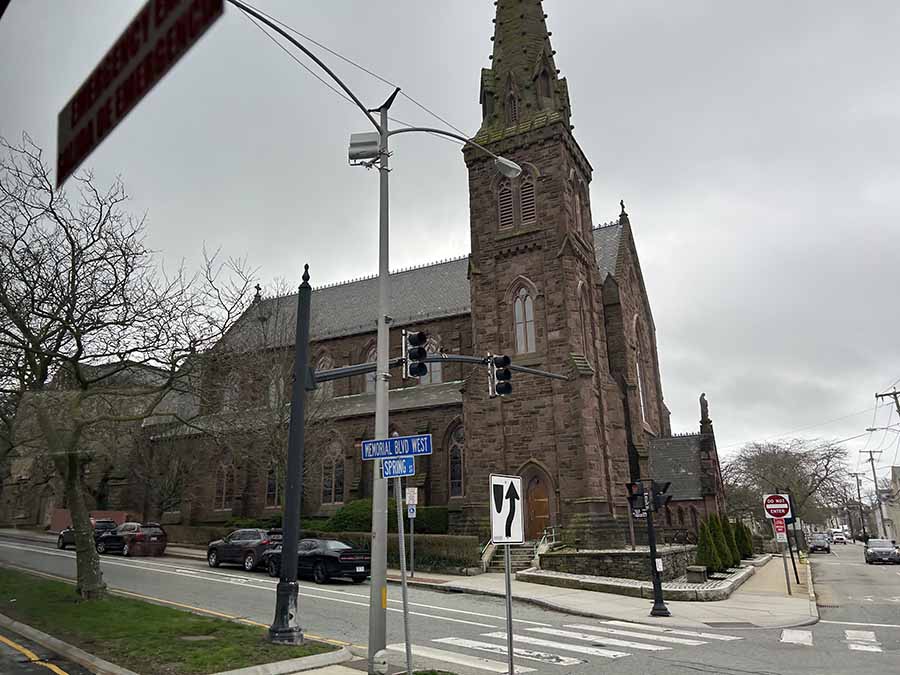
“Black Jack’ on the booze, JFK & Jackie’s wedding
On September 12, 1953, Massachusetts Senator John F. Kennedy, then 36, married Jacqueline Lee Bouvier, 24, at Saint Mary’s Catholic Church in Newport, Rhode Island.
The wedding, dubbed the “society event of the season,” took place in Newport, where Jackie’s mother and stepfather, Janet and Hugh Auchincloss, owned Hammersmith Farm, a 300-acre oceanfront estate. The ceremony was followed by a lavish reception at Hammersmith Farm, Jackie’s childhood summer home.
Jackie’s biological father, John “Black Jack” Bouvier, was excluded from pre-wedding events due to tensions with her mother’s family. Hurt, he got drunk the night before and was unable to escort Jackie down the aisle, a role filled by her stepfather, Hugh Auchincloss. Photos of Jackie entering the church show a composed but reportedly furious expression.
Jackie and her mother envisioned a small, intimate wedding, but Joseph Kennedy orchestrated a grand spectacle to boost JFK’s political profile, footing the bill to override objections. This led to compromises, like Jackie’s dress choice, and strained family dynamics.
JFK, known for philandering, was reportedly hesitant about marriage, with a friend noting his depression days before the wedding. Despite genuine affection, the couple’s union was shaped by political and social pressures.
The wedding marked the beginning of the Kennedy “Camelot” mythos, blending glamour, power, and tragedy. It was a national event, covered extensively by outlets like Life and Vogue, and set the stage for JFK and Jackie’s ascent to the White House in 1961 as the youngest president and first lady. The event’s legacy endures through St. Mary’s “Return to Camelot” programme, which draws tourists to relive the day with film screenings, music, and historical tours. The wedding also highlighted Ann Lowe’s talent, though she received little credit at the time, a point of later contention.
While celebrated as a fairytale, the wedding reflected the era’s social dynamics—wealth, privilege, and political maneuvering. The exclusion of Black Jack Bouvier and the lack of initial credit for Ann Lowe underscore personal and societal tensions.
The wedding dress is preserved at the JFK Presidential Library and Museum, with replicas displayed in exhibits like the 2023 “Ann Lowe: American Couturier” at the Winterthur Museum. Hammersmith Farm later served as a “summer White House” during JFK’s presidency.
Boston’s Archbishop Richard Cushing, a Kennedy family friend, officiated the Catholic Mass, assisted by four priests. A special blessing from Pope Pius XII was read, adding papal prestige. Over 750–800 guests attended, including senators, diplomats, Hollywood stars, and socialites, with 3,000 onlookers crowding outside the church. The guest list reflected the Kennedys’ political ambitions and the Bouviers’ social prominence.
Jackie wore an ivory tissue silk gown designed by African-American couturier Ann Lowe, featuring a portrait neckline, fitted bodice, and a bouffant skirt with over 50 yards of flounces, adorned with rosettes and wax flowers. The dress, though traditional, wasn’t Jackie’s preferred modern French style, as Joseph Kennedy, JFK’s father, insisted on a voter-friendly design. Her rosepoint lace veil, borrowed from her grandmother Margaret Lee, was paired with a tiara, a pearl choker, and a diamond bracelet (gifts from JFK). Her bouquet included pink and white spray orchids and gardenias. A pipe burst in Lowe’s studio 10 days prior nearly destroyed the gown and bridesmaid dresses, but Lowe remade them without informing the family.
Jackie’s attendants included her sister Lee Bouvier (matron of honor), stepsister Nina Auchincloss, and future sister-in-law Ethel Kennedy, among others. JFK’s brothers Robert (best man) and Edward, along with friend Charles Bartlett (who introduced the couple), were groomsmen. Flower girl Janet Auchincloss, Jackie’s half-sister, added charm to the scene.
Tenor Luigi Vena sang “Ave Maria,” and the ceremony was steeped in Catholic tradition, with guests packed into the church’s pews. The Kennedys’ reserved pew 10, where they worshipped during Newport visits, became a focal point for later tourists.
The reception at Hammersmith Farm hosted 900–1,200 guests, with 400 additional invitees joining after the ceremony, creating a “human traffic jam.” The newlyweds spent two hours shaking hands in the receiving line. Notable attendees included Robert Kennedy, Eunice Kennedy Shriver, and U.S. Speaker of the House Joe Martin.
Details: The Meyer Davis Orchestra played “I Married an Angel” for the couple’s first dance. A four-foot-tall wedding cake, baked by William Paul of Plourdes Bakery, was a centerpiece, with guests like Janet Auchincloss playfully offering slices. The alfresco luncheon featured traditional fare, and the couple was showered with rose-petal confetti and rice as they departed.
Life magazine, with photographer Lisa Larsen, covered the event, publishing photos that likened the wedding to a “coronation.” The media frenzy underscored the Kennedys’ rising stardom, with 50–100 journalists present.
The church’s ties to the Kennedy family extend beyond the wedding, as they worshipped there during Newport visits, reserving pew number 10. The parish has capitalized on this legacy with its “Return to Camelot” program, launched in 2017, which allows visitors to relive the Kennedy wedding through vintage film clips, live organ music, and tours of the church, including the kneelers used during the ceremony. These events, held annually to mark the wedding anniversary, support charitable programs like the St. Mary’s Hot Lunch Program. The church’s historical marker also notes its role as a Catholic heritage site, built near the first land owned by the Catholic Church in Rhode Island.
St. Mary’s role as a Catholic landmark ties it to Rhode Island’s religious history, but its Kennedy connection overshadows broader narratives, such as the church’s early role serving Irish and working-class Catholics. The “Return to Camelot” program, while nostalgic, could expand to explore these layers, balancing glamour with historical context.
The church, located at 12 William Street in Newport, Rhode Island, is the oldest Catholic parish in the state, established by newly-rdained Father Robert Woodley in 1828, sent to the area by Bishop Benedict Fenwick of Boston at a time when the construction of Catholic churches was still illegal in many parts of the USA.
The first significant migration of Catholic Irish to North America began in the aftermath of the War of 1812, and between 1815 and 1845 five thousand Irish settled in Rhode Island. In the first US census of 1850, Ireland provided 69pc of the foreign born population. Most of the congregation of 600 served by Father Woodley in 1828 were Irish laborers working on Fort Adams.
Dedicated in 1852, the Gothic Revival-style church was designed by Patrick C. Keely, America’s first prominent Catholic church architect, and consecrated to the Virgin Mary under the title “Holy Name of Mary, Our Lady of the Isle.” The church’s exterior features brownstone construction, while its interior boasts 42 vibrant stained-glass windows crafted by the Austrian Tyrolean Art Glass Company, added around the turn of the 20th century. These windows, with blue and red themes, depict scenes from the life of Christ and the Virgin Mary. The church is listed on the National Register of Historic Places, reflecting its architectural and cultural significance. It remains an active parish, serving the Newport community with regular Masses, a hot lunch program for those in need, and outreach initiatives.
The Gothic Revival design includes pointed arches, ribbed vaults, and intricate stonework, typical of mid-19th-century Catholic churches. The interior features ornate wooden carvings, including cherubs, and a high altar. The 42 windows are a highlight, creating a luminous atmosphere with their detailed biblical scenes.
In 2016, architects began restoring the church to its 1953 appearance, using original blueprints to recreate the setting Jackie saw as she walked down the aisle. A Casavant Frères organ, installed in 1958, is a feature of the church.
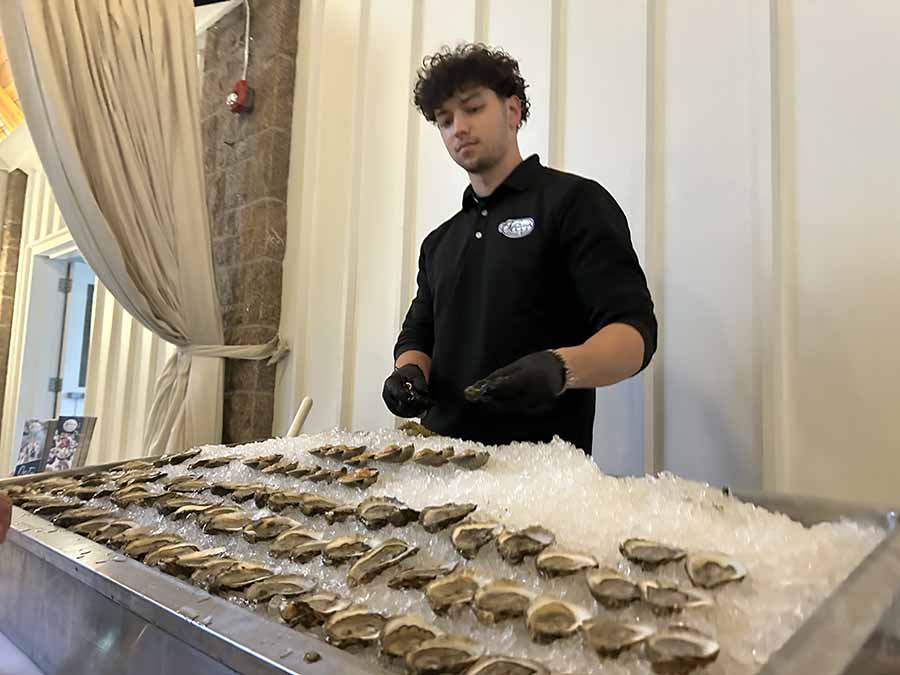

Further afield: Shepherd’s Run
Situated in South Kingstown, Rhode Island, thirty minutes from Newport just an hour and a half from Boston and venue for an evening event at Discover New England Tourism forum 2025, Shepherd’s Run is a former Sisters of the Cross and Passion convent and.historic estate turned modern winery, resort, and event venue, set on a picturesque 36-acre property located in South Kingstown, Rhode Island, at 4780 Tower Hill Road, Wakefield.
Established in 1933 as the summer residence of Rush Sturges and Elizabeth Hazard Sturges, the historic manor house was designed in the Norman Romanesque style by architect Thomas Pym Cope, with gardens by famed landscape architect Beatrix Farrand. A convent from 1959 and boarding school since 1966 (sister convent to those in Kilcullen and Ballycaste), the property was revitalised in 2020 by Ryan Schoen and Ashley Morgan of Morgan Schoen Hospitality, transforming it into a luxurious yet low-key retreat.
The vineyard produces small-batch wines, including riesling, rosé, pinot noir, syrah, and blanc de blanc, available for tastings by reservation. The winery emphasizes local terroir and sustainable practices, with a tasting room offering panoramic views. Guests can enjoy curated food pairings, such as cheeses and charcuterie, though outside food is permitted at picnic tables on the lawn.
Notable spaces include the 3,000-square-foot Event Hall, the Beatrix Farrand-designed Walled Garden for ceremonies, the Manor Terrace for cocktail hours, and a boho-chic sailcloth tent for receptions. The Winemaker’s Room and Wine Hall are ideal for smaller events. Blackstone Caterers, the exclusive catering partner, offers customizable menus, from appetizers to formal dinners, with a focus on local ingredients. Weddings are highly praised for their beauty and service, though some find the venue pricey, with catering minimums starting at $25,000–$30,000 plus venue fees.
The property’s grounds are serene, with rolling hills, vineyards, and historic architecture, including original door handles, archways, and tiles. It’s a short drive from Narragansett’s beaches and 21 miles from T.F. Green Airport. Guests appreciate the tranquil vibe, photo opportunities, and activities like jewelry-making workshops or seasonal events, such as Easter brunch. However, some reviews mention overpricing or underwhelming spaces like the courtyard or ballroom floor.
Shepherd’s Run combines the charm of a 1933 Norman Romanesque manor with contemporary upgrades following a major renovation completed in 2021 by owners Ryan Schoen and Ashley Morgan. The estate features rolling vineyards, lush gardens, and serene views of the Narrow River, evoking a European countryside escape. The main building’s stone façade, arched windows, and original details like door handles and tiles blend seamlessly with modern additions like a sailcloth tent and sleek interiors.

The estate is open Wednesday to Sunday from 11 AM to 6 PM, Shepherd’s Run offers a multifaceted visit. It’s a winery first, with tasting rooms like the dramatic dark-blue Rush Sturges Study or the light-filled Wine Hall, but it’s also a boutique hotel with 26 guest rooms, a spa, and event spaces. The vibe is sophisticated yet relaxed, appealing to wine lovers, wellness seekers, and event-goers. The property’s history as a summer home, convent, and boarding school adds a layer of intrigue.
Wine tastings typically start around $15-$25 per flight, with bottles ranging from $25-$40. Room rates begin at $200-$300/night off-season, climbing higher in summer. Event catering (e.g., weddings) has minimums like $25,000-$30,000 depending on the day.
A 90-minute drive from Boston, it’s ideal for a day trip or weekend getaway. Free parking is ample, and the shuttle to Narragansett beaches (15 minutes away) adds convenience.
Staff are attentive and wine-savvy, though some visitors note a brisk pace during peak times. The focus is on the experience—wine, views, and relaxation—over fussy formality.
Visitors to Shepherd’s Run can expect a polished yet laid-back retreat where wine, history, and nature converge. It’s less about a single “signature dish” and more about the curated experience: sipping a glass of estate-inspired Pinot Noir on the terrace, unwinding in the spa, or toasting in the garden. Whether you’re there for a tasting, a stay, or a celebration, it is a slice of Rhode Island’s coastal charm with a modern twist. Activities include:
- Wine Tasting: Reservations are recommended for tastings, especially during busy periods, as seating is limited. Guests can enjoy flights, glasses, or bottles in various indoor and outdoor spaces, guided by knowledgeable staff.
- Spa and Wellness: The Seawater Spa offers massages, facials, and nail services, while a yoga studio hosts free classes (schedule varies). There’s also a seasonal outdoor heated pool and a small fitness room.
- Exploration: Wander the grounds, including the Beatrix Farrand-designed walled garden, vineyard trails, or the terrace with its vineyard views. The historic chapel, now a flexible event space, adds architectural allure.
- Events: From intimate gatherings to weddings for up to 300, the estate hosts live music, art workshops, and seasonal happenings like Easter brunch or jewelry-making classes with local artisans.
- Accommodations: The 26 rooms range from cozy doubles to suites, blending New England elegance with modern comforts like pillowtop beds, Frette sheets, and vineyard views. Some guests note noise from events, but the cleanliness and charm are consistent highlights.
- Crowds and Timing: Summer and autumn are peak seasons, with weekends drawing locals and tourists for wine and weddings. Winter offers a quieter, cozier stay, often at lower rates.
- Pinot Noir: A flagship varietal, with vines planted in 2021. Though estate-grown grapes are still maturing (first harvest expected around 2025-2026), their Pinot Noir, sourced regionally for now, is praised for its bold yet nuanced profile—a rarity in New England’s white-heavy wine scene.
- Rosé: A crisp, refreshing option, popular in tastings and often featured in flights or by the glass on the terrace.
- Blanc de Blanc: A sparkling white that showcases their innovative winemaking, overseen by Michael Harney (formerly of Jonathan Edwards Winery). It’s light, effervescent, and a favorite for celebrations.
- Riesling and Syrah: These round out the core lineup, offering a mix of dry and fruity notes that highlight small-batch craftsmanship. The winery aims to blend estate-grown and regional grapes, emphasizing terroir over mass production.
- Food Pairings include Cheese and Charcuterie Boards: Available with tastings or as a la carte options, these feature local Rhode Island cheeses, cured meats, and seasonal accompaniments—perfect for a leisurely afternoon on the deck.
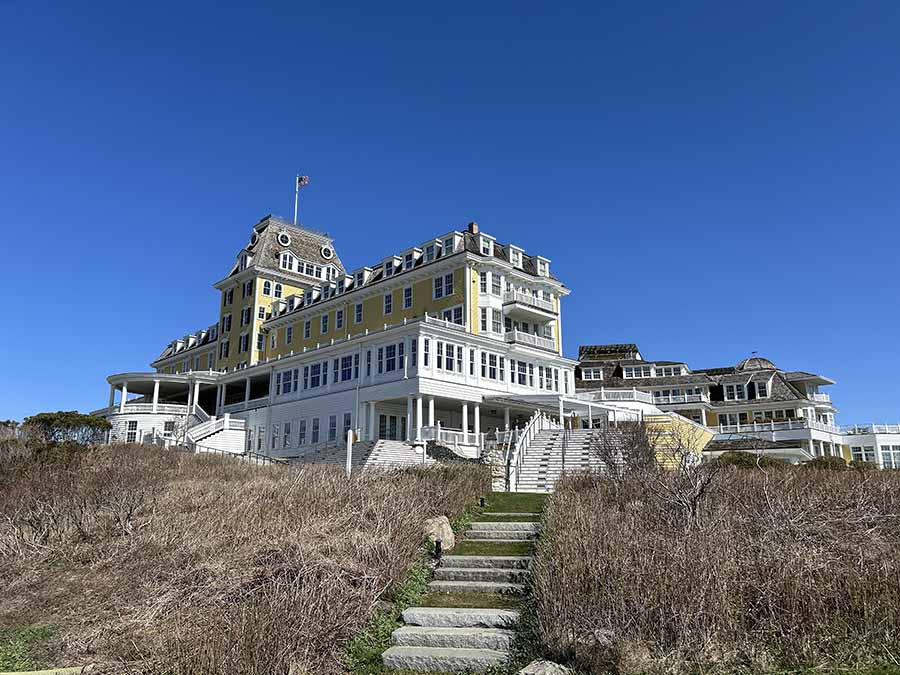
Further afield: Ocean House
A visit to Ocean House in Watch Hill, Rhode Island, promises a luxurious and timeless escape at one of New England’s most iconic seaside resorts. Perched on a bluff overlooking the Atlantic Ocean in the charming village of Watch Hill, this historic hotel—rebuilt in 2010 to replicate its original 1868 Victorian design—blends Gilded Age elegance with modern sophistication. As the only AAA Five Diamond and Forbes Five-Star hotel in Rhode Island, with its spa and restaurant (COAST) also earning Five-Star ratings, Ocean House stands among an elite group of just 14 triple Five-Star resorts worldwide.
Approaching via Bluff Avenue, you’re greeted by the hotel’s signature yellow façade, a warm beacon atop the bluffs with sweeping views of Block Island Sound and Little Narragansett Bay. The 13-acre estate feels secluded yet accessible—roughly 45 minutes from Newport, 1.5 hours from Boston, and 3 hours from New York City. The quaint Watch Hill village, with its boutiques and seafood shacks, adds small-town charm, while Taylor Swift’s nearby holiday home hints at the area’s celebrity allure.
The vibe is refined yet relaxed, evoking a golden age of hospitality. The Victorian architecture—complete with gabled roofs, wide verandas, and over 5,000 salvaged artifacts like the original front desk—pairs with modern comforts. It’s a gratuity-free property (tips included in the daily resort fee), fostering a seamless, stress-free experience.
Expect a polished yet welcoming retreat where history meets luxury. You might sip a garden-inspired cocktail on the veranda, savor a creamy chowder while gazing at the Atlantic, or unwind with a sea-inspired massage—all underscored by impeccable service. The staff’s attentiveness (they call 10 days prior to tailor your visit) ensures a personal touch, whether you’re there for a meal or a full day. It’s a splurge—prices reflect the Five-Star pedigree—but the blend of coastal serenity, culinary excellence, and Victorian charm makes it a standout escape, even for a few hours. Pair it with a Watch Hill stroll or Ocean Drive loop for a perfect Rhode Island day.

The private white-sand beach is reserved for overnight guests, but day visitors can enjoy the seasonal outdoor saltwater pool or the year-round indoor heated pool (access may depend on your package). Beach activities like paddleboarding or cabana lounging tantalise from afar.
- OH! Spa is Rhode Island’s only Forbes Five-Star spa, this 12,000-square-foot oasis offers massages, facials, and seasonal treatments using local ingredients (e.g., seaweed or honey). Day visitors can book services, unwinding in the herbal steam room or relaxation lounge.
- The centre for wine & culinary arts is a highlight for foodies. It offers complimentary wine tastings (“Sipping with the Somm”) and culinary demos—think local oyster shucking or pastry lessons. Day guests can join with advance booking (some classes have a fee).
- Wander the croquet lawn, putting green, or sculpture gardens, or join a complimentary fitness class like yoga. The historic Watch Hill Lighthouse nearby adds a scenic detour.
- Ocean House’s dining options cater to many tastes, with day visitors welcome at most venues (reservations strongly recommended):
- COAST: The Forbes Five-Star restaurant serves a seasonal four-course menu of farm-to-table Northeast cuisine—think native lobster, foraged mushrooms, or seared scallops. It’s elegant and intimate, with dishes changing daily to reflect the freshest catch (entrees ~$40-$60). Dinner only, jackets suggested for men.
- The Bistro: A casual twist on New England classics, offering lunch and dinner. Signature dishes include New England Clam Chowder: Creamy, briny, and packed with local clams—a Rhode Island staple, Short Rib Sandwich: Tender braised beef with a crisp roll, often paired with house fries, Grilled meats and seafood sourced from nearby farms and waters round out the menu (~$20-$35).
- The Verandah (summer only): Alfresco dining with a raw bar and Rhode Island specialties like lobster rolls or chilled seafood towers. Expect ocean breezes and bar nibbles like spiced nuts (~$15-$40).
- Dalia: On the Seaside Terrace, this spot offers bold Mexican-inspired fare—think ceviche, grilled octopus, or whole market fish—with expansive ocean views (~$25-$50). Seasonal and hotel-guest priority.
- Dune Cottage: Mediterranean-inflected casual fare (e.g., rack of lamb or fresh fish) for lunch and dinner, reserved for hotel guests but a visual treat for day visitors passing by.

Heliblock Tours
A Heliblock Tour over South County, Rhode Island, offers visitors an exhilarating aerial adventure showcasing the stunning coastal landscapes and charming towns of this southern region of the state. Based out of Westerly State Airport in Westerly, Rhode Island, Heliblock provides a range of helicopter tours that highlight the natural beauty and historic landmarks of South County, which includes towns like Westerly, Watch Hill, Misquamicut, and Weekapaug, as well as nearby areas like Block Island and Fishers Island.
Tours begin at Westerly State Airport, where you’ll meet your pilot and board a well-maintained Robinson R44 helicopter, operated by Heliblock’s experienced and certified pilots. The small-group setting (typically 2-3 passengers) ensures a personal experience, with options for doors-on or doors-off flights—doors-off amplifying the thrill and offering unobstructed views (weather permitting). A safety briefing precedes takeoff, and headsets allow you to hear the pilot’s narration over the rotor noise.
Once airborne, you’ll lift off smoothly, climbing to altitudes between 500 and 2,000 feet depending on the tour. The ride is surprisingly stable—not the bumpy thrill ride some might expect—though the doors-off option adds a rush of wind and a visceral connection to the landscape below. Flights range from 10-minute introductory jaunts to 60-minute extended explorations, with durations tailored to your chosen tour.
Expect a thrill that starts the moment you lift off, with South County shrinking into a toy-like panorama below. The pilot’s insights—like spotting oyster farms or tracing the coastline’s curve—add depth to the jaw-dropping views. It’s less about adrenaline (though doors-off delivers that) and more about awe: the patchwork of beaches, ponds, and villages feels both familiar and surreal from above. Past visitors rave about the smooth ride, friendly pilots (Josh and Mike often get shoutouts), and the “once-in-a-lifetime” perspective—whether it’s a 95-year-old’s first flight or a kid’s “best day ever.”
South County’s coastline unfolds beneath you in miniature splendor:
- Watch Hill: Fly over this quaint seaside village, spotting its Victorian homes, the Watch Hill Lighthouse (built 1857), and Taylor Swift’s famous holiday estate perched on the bluff.
- Misquamicut Beach: See the sandy stretch of this popular state beach, its waves lapping against the shore, and landmarks like Water Wizz and Bayview Fun Park.
- Winnapaug Pond: Marvel at the oyster beds arranged in neat rows—an underwater farm visible only from above—framed by salt marshes and golf courses like Weekapaug and Winnapaug Country Club.
- Pawcatuck River: Trace its winding path as it flows into Little Narragansett Bay, offering a bird’s-eye view of Westerly’s waterfront.
- Ocean Vistas: On clear days, gaze out to Block Island, Fishers Island, or even Montauk, with the Atlantic sparkling below.
Pilots double as guides, pointing out landmarks and sharing local lore—like the history of Watch Hill’s Ocean House or the ecology of the ponds. Tours range from 10 minutes to an hour, with 30-minute flights being the sweet spot for depth without fatigue. Add 15-30 minutes for check-in and briefing. Prices start at $109 per person for shorter tours, climbing to $425 for extended options like Autumn Foliage. Private charters offer better value for couples or small groups.
- Heliblock offers several South County-focused tours, each with unique sights.
- The Watch Hill Experience (~10-15 minutes): A quick loop over Watch Hill Point, the Westerly shoreline, Misquamicut Beach, and Weekapaug—ideal for first-timers. ($109-$150 per person.)
- Fishers Island to Weekapaug (~20-30 minutes): Extends from Watch Hill along the coast, then out to Fishers Island in New York waters, circling back over Quonochontaug Pond. Offers high and low-altitude perspectives. (~$209 per person or $249 for a private two-person charter.)
- Block Island Crossing (~30-45 minutes): Starts with Watch Hill and Misquamicut, then crosses Block Island Sound for aerial views of New Shoreham, Great Salt Pond, and Mohegan Bluffs before returning. (~$209 per person or $459 private for two.)
Reservations are essential, especially in summer—book online at heliblocktours.com or call (401) 859-1001. A free shuttle from Misquamicut simplifies logistics for Westerly visitors.

Further afield: Ninigret Park
A visit to Ninigret Park and its famous Thomas Dambo Trolls in Charlestown, Rhode Island, offers a delightful mix of outdoor recreation, natural beauty, and whimsical art. Located at 5 Park Lane in South County, this 227-acre park has long been a local gem, but the addition of giant troll sculptures in May 2024 has transformed it into a must-see destination. Here’s what visitors can expect as of April 7, 2025:
Ninigret Park sprawls across a former Naval Air Station site, blending open fields with wooded trails and wetlands. It’s bordered by Little Ninigret Pond and Ninigret Pond, offering serene water views and a coastal breeze. The park’s layout includes paved paths, dirt trails, and expansive green spaces, making it ideal for a leisurely day out.
Two giant trolls, Erik Rock and Greta Granite, crafted by Danish artist Thomas Dambo from recycled wood, shells, and natural materials, are the park’s stars. Unveiled in May 2024 as part of a planned Rhode Island Troll Trail, these 16-foot sculptures blend seamlessly into the landscape, embodying Dambo’s conservation message—turning trash into treasure.
The trolls tie into Dambo’s “Thunderstone” narrative—a mythical quest involving sacred stones. Clues at each troll hint at future sculptures (three more are planned by 2025-2026 across Rhode Island). Since their arrival, over 60,000 visitors flocked to Ninigret last summer .
Made of untreated recycled wood, the trolls weather naturally—expect some wear by 2025, adding to their rustic charm. They’re built to last years, though not forever, per Dambo’s philosophy.
Expect a blend of whimsy and wonder. The trolls’ towering, quirky presence—Erik’s laid-back pose, Greta’s majestic kneel—sparks joy and curiosity, especially for kids who love the treasure-hunt feel. The park’s diverse offerings mean you can tailor your day: hike to the trolls, then swim, play, or stargaze. It’s a family-friendly adventure with a touch of magic, set against South County’s coastal charm. Locals and tourists alike rave about the craftsmanship and the way these “gentle giants” lure you into nature—perfect for a memorable Rhode Island escape.
- Erik Rock: Found near Little Ninigret Pond, just off the main path by the Frosty Drew Observatory, Erik lounges against a tree, adorned with a birdhouse necklace. His yellow footprint trail guides you from the parking lot—a 5-minute walk (about 0.2 miles) from the playground lot.
Greta Granite: Hidden deeper in the woods, Greta kneels among boulders, her intricate necklace of oyster shells, driftwood, and local art pieces a collaborative effort with volunteers. She’s a 10-15 minute hike (0.5-0.7 miles) from Erik, following signs toward the Senior Centre, then a marked trail with shell clues overhead.

Matunuck Oyster Bar
A visit to Matunuck Oyster Bar in South Kingstown, Rhode Island, offers a quintessential “pond-to-plate” dining experience that celebrates the freshest seafood and local produce in a charming coastal setting.
Our visit began with a boat trip narrated by Oliver Dixon, who explained the science of oyster famring to help whip up an appetite. “The whole coastline just grows these beautiful products. I think one of the biggest problems is there’s just so many good oysters out there. right? It’s like tough to try them all”
Located at 629 Succotash Road, overlooking Potter Pond, this acclaimed restaurant—named one of USA TODAY’s 2024 Restaurants of the Year—combines a laid-back vibe with culinary excellence, drawing seafood lovers from near and far.
The restaurant hosts a waterfront patio with covered and open seating, offering serene views of the oyster farm and marina where the day’s catch is hauled in. The indoor dining area is smaller but equally inviting, with a casual yet classy feel—think wooden accents, nautical touches, and big windows framing the water. A heated rooftop deck adds extra space and ambiance, especially in cooler months. The vibe is lively yet relaxed, blending beachy charm with a touch of sophistication, though summer crowds can make it bustling—reservations (up to 21 days ahead) are a must.
The focus is on freshness, with oysters pulled from the pond just steps away and herbs and veggies sourced from the restaurant’s organic farm on the north end of Potter Pond. Diners can watch oysters being cleaned on the dock from window seats or the patio, reinforcing the farm-to-table ethos. Service is friendly and attentive, though it can lag during peak times due to high demand. The young waitstaff keep things upbeat, and the open layout lets you soak in the coastal energy. For a deeper dive, weekend oyster farm tours (60 minutes by barge, $25/person) offer a firsthand look at aquaculture, complete with an intro to global and local fisheries.
Visitors can expect a memorable meal where the proximity to the source—oysters from the pond, greens from the farm—elevates every bite. It’s not just dining; it’s a celebration of Rhode Island’s aquaculture legacy, wrapped in a postcard-worthy setting. Whether you’re slurping oysters at sunset or savoring a stuffed lobster indoors, Matunuck Oyster Bar delivers a taste of the Ocean State that’s hard to beat.

The restaurant is open year-round for lunch and dinner (typically 11:30 AM to 9:00 PM, though hours flex seasonally), it’s busiest in summer—expect long waits even with reservations. Off-season visits (autumn or winter) promise a quieter meal with the same quality, plus easier parking (valet-only is a recent perk). The atmosphere shifts from frenetic in July to mellow in January, but the seafood shines regardless. Signature dishes include:
- Matunuck Oyster Bar’s menu leans heavily on its own farm-raised shellfish and wild-caught seafood, paired with creative spins on New England classics. While specials rotate with the seasons, these signature offerings stand out:
- Matunuck Oysters: The star of the show—grown in Potter Pond right off the patio, these petite Eastern oysters (Crassostrea virginica) are prized for their subtle brine and sweet finish. Served raw on the half-shell from the signature raw bar, they’re often paired with a crisp mignonette or a bottle of Taittinger Champagne for a luxurious touch. Diners can’t get fresher—you’re eating them where they’re harvested.
- Clams Casino: A Rhode Island icon perfected by owner Perry Raso and his chef after statewide research. Littleneck clams are stuffed with bell peppers, bacon, breadcrumbs, and a hint of sherry, then baked to a savory, golden finish—a nod to the state’s clam shack heritage with a refined twist.
- Stuffies: Classic Rhode Island stuffed quahogs (large clams) packed with a spicy, herbaceous filling of chopped clams, breadcrumbs, and local seasonings. They’re hearty, briny, and a must-try for a taste of local tradition.
- Clear-Broth Rhode Island Chowder: Unique to the state, this light, translucent chowder skips the cream for a clean, seafood-forward flavor—loaded with clams, potatoes, and a delicate broth that lets the ingredients shine.
- Lobster Roll: A New England staple served hot or cold, piled high with tender lobster meat on a buttered roll. It’s simple yet decadent, showcasing Rhode Island’s coastal bounty.
- Stuffed Lobster: An extravagant treat—whole lobster filled with a seafood medley (think shrimp, scallops, or crab), baked to succulent perfection. It’s a showstopper for special occasions.
- Scallop Specials: A menu mainstay with ever-changing preparations, like seared scallops over butternut squash risotto with cauliflower cream or paired with farm-fresh veggies. The focus on local day-boat scallops ensures peak freshness.
- Beyond shellfish, the menu offers lobster pizza, crab, calamari, sushi, and non-seafood options like steak, chicken, and veggie dishes—something for everyone, though seafood is the draw. Prices reflect the quality (raw bar $15-$30, entrees $20-$50), and portions are generous.
- Drinks: A solid wine list, local beers, and cocktails like a Bloody Mary with a jumbo shrimp garnish complement the meal. The patio bar is a summer hotspot.
Links: Discover New England tourism forum – DNE media panel discussion –
Boston city – Afternoon tea in Boston library – Boston Museum of Fine Art – China Pearl, in Boston’s Chinatown – Isabella Stewart Gardner Museum – View Boston panoramic tower
Hartford, Connecticut – Madison, Connecticut – Mashantucket Pequot Museum – Mystic Seaport Museum – Mystic, Connecticut – New Bedford, Massachusetts – New Haven Connecticut – South Eastern Massachusetts – Westerly, Rhode Island



